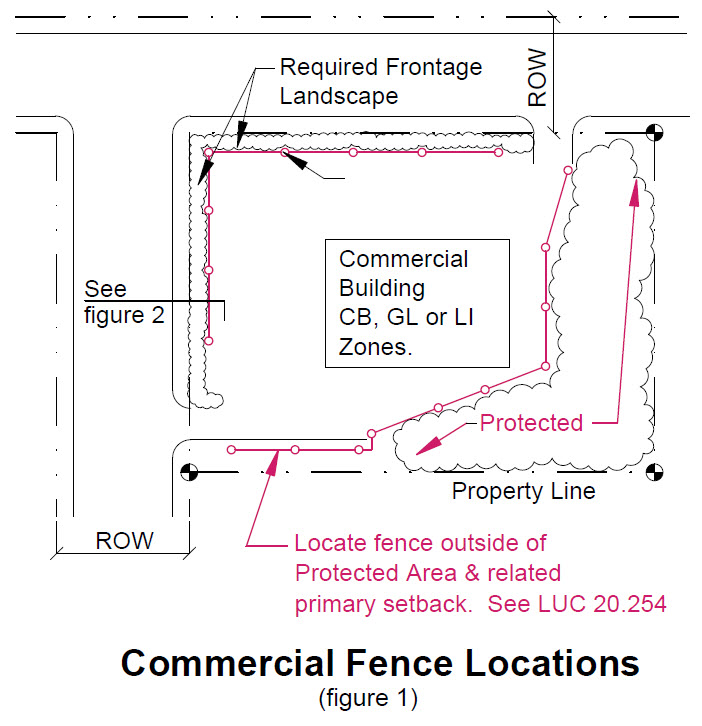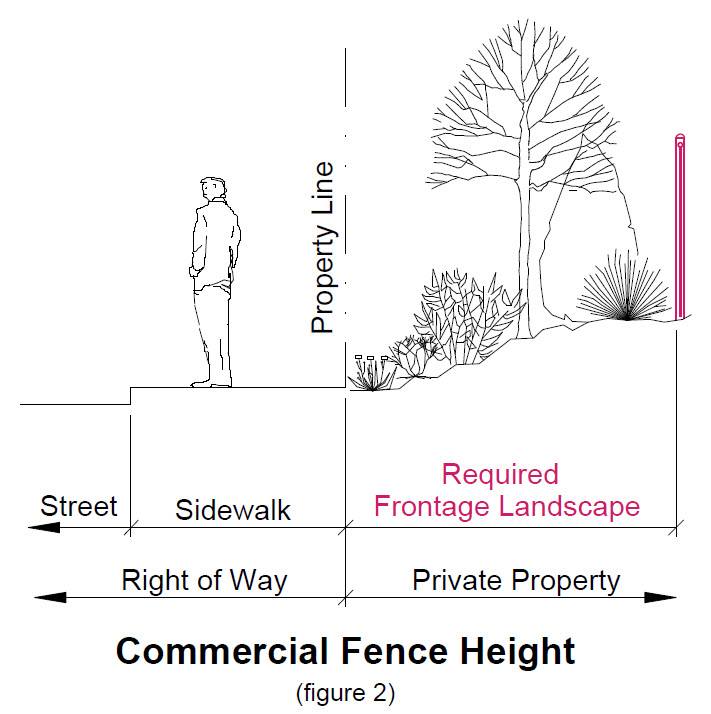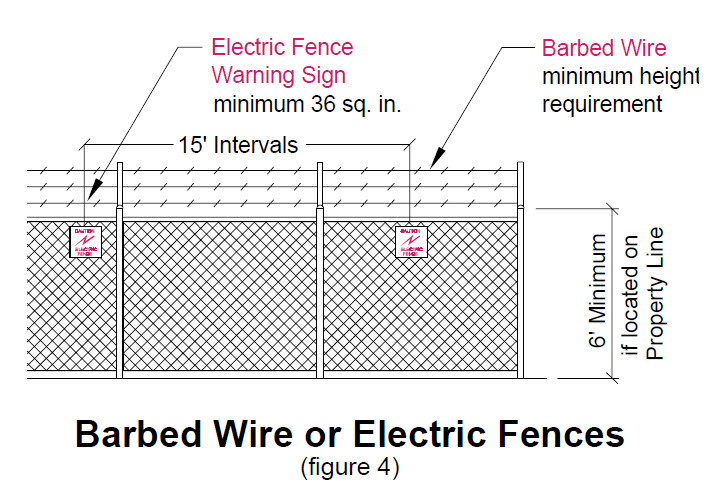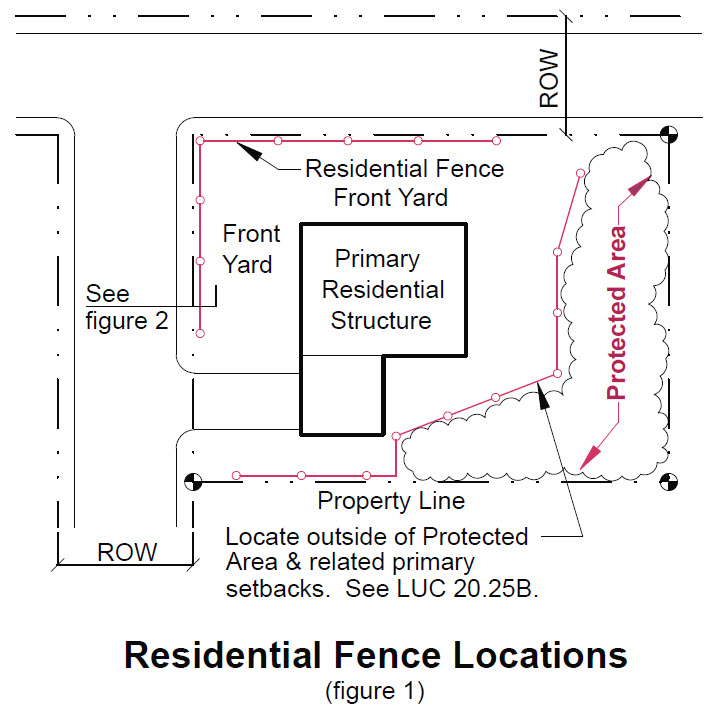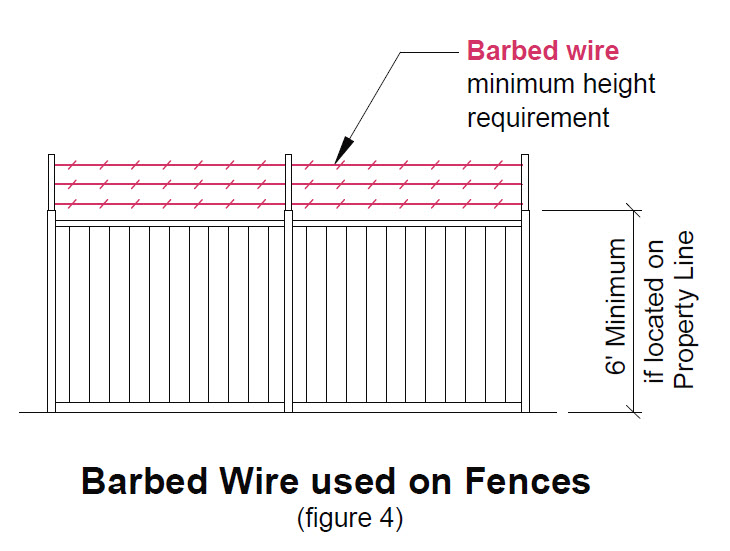
Fences provide privacy, screening, and containment. In some cases a fence may not be allowed, such as near a stream or other critical area and may be limited in height if a fence is in a front yard. Fences taller than eight feet require a building permit approval.
Commercial Fences
This information for is applicable to building a fence on your commercial property. It answers the most common questions about the city requirements and allowances for commercial fences .
Where can my fence be located?
Generally, anywhere on your property. However, the fence location will determine its allowable height. It is not required to be set back from your property line unless your property contains a Protected Area (wetland, stream, steep slope) or is within the Shoreline Overlay District. In such cases, refer to Land Use Code (LUC) 20.25E and LUC 20.25H.
How tall can my fence be?
Fences in a required front-yard setback may not exceed 4 feet, 6 inches, except under certain circumstances discussed below. See LUC 20.20.010 for front-yard setback requirements for your district. See LUC 20.25A for Downtown zone setbacks and LUC 20.25D for Bel-Red zone setbacks.
Fences exceeding 4 feet, 6 inches, but no taller than 8 feet, may be located anywhere except within the required front-yard setback. Fences over 8 feet are permitted with a building permit but may not be located within any required front-, rear-, or side- yard setback.
A fence must not violate the sight-obstruction restrictions at street intersections. Those restrictions are found in Bellevue City Code (BCC) 14.60.240 and BCC 14.60.241 and vary by type of intersection. If your fence will be located near a driveway or street intersection, contact the Transportation Department for additional information on sight-obstruction restrictions.
What exceptions are there to fence height limits in a front yard?
Exceptions to the 4 feet, 6 inches height limit in the front setback are allowed in any of the following situations:
- The fence is perpendicular to the right of way and is necessary for screening; or
- The fence is located on an arterial; or
- The fence is located on one side of a corner lot.
In addition, certain chain link fences are permitted in a front setback in some districts
The fence must meet the following criteria.
- The fence will not exceed the minimum height necessary to afford privacy, security, screening, or noise attenuation; and
- The fence will not cause or contribute to a hazardous traffic situation; and
- The fence is necessary to afford reasonable privacy, security, or noise attenuation to the subject property; and
- The design of the fence is in character with the development in the immediate neighborhood, and the finished side of the proposed fence faces the right of way or the adjacent property.
Who determines whether my front- yard fence qualifies for increased height?
The land use planner in Development Services at City Hall can determine if your property will qualify for an increased fence height in the front-yard setback.
How is fence height measured?
Height is measured from the finished grade along the exterior side of the fence to the top of the fence. If a fence is built on top of a berm, the combined height of the fence and berm must not exceed the allowable fence height. On sloping ground the fence must follow the slope or step with the slope so as not to exceed the allowable height at any point along the fence.
Are chain link fences allowed?
Yes. And chain link security fences may be permitted in a front-yard setback in a CB, GC, or LI District or in commercial parking lots and storage areas if plans are approved by the Director of Development Services. The fence must not violate sight- obstruction restrictions nor stand in or in front of any required landscaping. Chain link fences may not be allowed in districts subject to design review.
Is barbed wire fencing permitted?
Yes. But if used along a property boundary, it must be placed on top of a solid or chain link fence that is at least 6 feet high. Barbed wire fencing may not be allowed in districts subject to design review.
Do I need a permit to build a fence?
You do not need a permit unless your fence exceeds 8 feet in height
Where can I get additional information?
- LUC 20.20.400 (Fences)
- LUC 20.50.020, Definition of Fence
- BCC 14.60.240 and BCC 14.60.241, Sight-obstruction Restrictions at Intersections
Electric Security Fences
This information answers basic questions related to electric security fences. Except as noted below, the requirements contained above apply to electric fences.
Can I install an electric fence?
Electric fences are permitted. In residential districts, electrical fences require additional fencing or other barriers to prevent access to the electric fence by small children from adjacent properties.
What requirements apply?
All electric fences must comply with the following:
- An electric fence using an interrupted flow of current at intervals of about 1 second on and 2 seconds off will be limited to 2,000 volts at
- An electric fence using continuous current will be limited to 1,500 volts at 7 milliamp current; and
- All electric fences will be posted with permanent signs a minimum of 36 square inches in area at intervals of 15 feet stating that the fence is electrified. Electric fences sold as a complete and assembled unit can be installed by an owner if the controlling elements of the installation are certified by an A.N.S.I.-approved testing agency.
Where can I get additional information?
- Land Use Code 20.20.400, Fences
- Bellevue City Code 14.60.240 and Bellevue City Code 14.60.241, Sight-obstruction Restrictions at Intersections
Residential Fences
This is applicable to building a fence on your residential property. It answers the most common questions about the city requirements and allowances for residential fences.
Where can my fence be located?
Generally, your fence may be located anywhere on your property, but its location will determine the allowable height. However, if your property contains a critical area–such as a wetland, stream, or steep slope–or is within the Shoreline Overlay District, limitations on fence location will apply. Refer to Land Use Code (LUC) 20.25E; or LUC 20.25H.
How tall can my fence be?
Fences in a required front-yard setback may not exceed 4 feet, 6 inches, except under certain circumstances discussed below. Fences not located in a front-yard setback may exceed 4 feet, 6 inches. The required front-yard setback is measured from the property line, not from the paved part of the right of way. In residential areas it is common for the right of way to extend beyond the paved street or sidewalk. This area is typically landscaped and maintained by the property owner and may appear to be part of the lot, but is actually within the right of way.
A fence must not violate the sight-obstruction restrictions at street intersections or driveways. Those restrictions are found in Bellevue City Code (BCC) 14.60.240 and BCC 14.60.241, and vary by type of intersection or the specific conditions of a driveway. If your fence will be located near a street intersection or driveway, contact the City of Bellevue Transportation Department for additional information on sight-obstruction restrictions.
What exceptions are there to fence height limits in a front yard?
Exceptions are allowed in the following situations—and only if the exception will allow for additional screening between adjacent lots or protection from the impacts of traffic on an arterial street, or will provide additional privacy for the back-yard portion of a corner lot.
A fence in a required front yard may exceed a height of 4 feet, 6 inches if any of the following situations exists:
- The fence is perpendicular to the right of way and is necessary for screening; or
- The fence is located on an arterial; or
- The fence is located on one side of a corner lot.
AND the fence must meet the following four criteria:
- The fence will not exceed the minimum height necessary to afford privacy, security, screening, or noise attenuation; and
- The fence will not cause or contribute to a hazardous traffic situation; and
- The fence is necessary to afford reasonable privacy, security, or noise attenuation to the subject property; and
- The design of the fence is in character with the development in the immediate neighborhood and the finished side of the proposed fence faces the right of way or the adjacent property.
Who determines whether my front-yard fence qualifies for increased height?
A land use planner in Development Services can determine if your property will qualify for an increased fence height in the front-yard setback.
How is fence height measured?
Height is measured from the finished grade along the exterior side of the fence to the top of the fence. If a fence is built on top of a berm or wall, the combined height of the fence and berm or wall must not exceed the allowable fence height. On sloping ground the fence must follow the slope or step with the slope so as not to exceed the allowable height at any point along the fence.
Is barbed wire fencing permitted?
Yes, but if used along a property boundary, it must be placed on top of a fence that is at least 6' high.
Do you need a permit to build a fence?
You do not need a permit unless
- Your fence exceeds 8 feet in height.
- The fence will be located within a critical area or critical area buffer.
- Your fence is to be constructed out of concrete blocks or similar material.
Can a free-standing wall be a fence?
A wall that is not used for retention of soil or other engineering purposes and solely is a wall that prevent entry to an area of a property is considered a fence and subject to the fence requirements for placement. Walls are a different structure than a fence and a permit is required for a wall if it is taller than 48 inches.
Where can I get additional information?
- LUC 20.20.400, Fences
- LUC 20.25E.080.Q, Residential Development Regulations in Shoreline Overlay District
- LUC 20.50.020, Definition of Fence
- BCC 14.60.240 and BCC 14.60.241, Sight-obstruction Restrictions at Intersections
